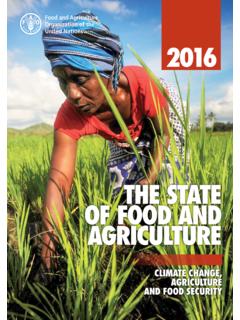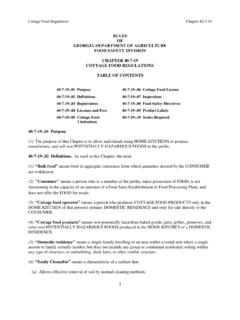Transcription of THE STATE OF FOOD AND AGRICULTURE
1 LEVERAGING food SYSTEMS FOR INCLUSIVE RURAL TRANSFORMATIONTHE STATEOF food AND AGRICULTURE2017 The designations employed and the presentation of material in this information product do not imply the expression of any opinion whatsoever on the part of the food and AGRICULTURE Organization of the United Nations (FAO) concerning the legal or development status of any country, territory, city or area or of its authorities, or concerning the delimitation of its frontiers or boundaries. The mention of specific companies or products of manufacturers, whether or not these have been patented, does not imply that these have been endorsed or recommended by FAO in preference to others of a similar nature that are not 978-92-5-109873-8 FAO encourages the use, reproduction and dissemination of material in this information product.
2 Except where otherwise indicated, material may be copied, downloaded and printed for private study, research and teaching purposes, or for use in non-commercial products or services, provided that appropriate acknowledgement of FAO as the source and copyright holder is given and that FAO s endorsement of users views, products or services is not implied in any requests for translation and adaptation rights, and for resale and other commercial use rights should be made via or addressed to information products are available on the FAO website ( ) and can be purchased through FAO 2017 HOI AN, VIET NAMP reparing food at a stall in the market.
3 Robert Francis/roberthardingCOVER PHOTOGRAPHFood and AGRICULTURE Organization of the United NationsRome, 20172017 THE STATEOF food AND AGRICULTURELEVERAGING food SYSTEMS FOR INCLUSIVE RURAL TRANSFORMATIONISSN 0081-4539 CONTENTSFOREWORD vACKNOWLEDGEMENTS viiiACRONYMS AND ABBREVIATIONS xEXECUTIVE SUMMARY xiCHAPTER 1 RURAL TRANSFORMATION: UNDERSTANDING THE PAST, LOOKING TO THE FUTURE 1 Key messages 1 Rural transformation is embedded in structural transformation 4 Past transformations led to uneven outcomes 4 Recent rural transformations: what is new?
4 8 Rural urban linkages and the food system 13 The rural urban spectrum : a new lens on urbanization and migration 14 Rural transformation comes with opportunities and challenges 21 Structure of the report 23 CHAPTER 2 food SYSTEMS, URBANIZATION AND DIETARY CHANGES 25 Key messages 25 Downstream transformation: urbanization 26 Downstream transformation: dietary changes 30 food system transformation 37 Conclusions and policy implications 43 IN FOCUS INTERNATIONAL TRADE, FOREIGN DIRECT INVESTMENT AND GLOBALIZATION OF THE food SYSTEM 44 CHAPTER 3 WHAT DOES THE FUTURE HOLD FOR FARMING SYSTEMS?
5 49 Key messages 49 Mechanization and technology are key drivers of farming system change 51 Land transformations: fragmentation, consolidation and markets 54 What is changing for farmers? 61 Challenges and opportunities for farmers in transforming food systems 66 Conclusions and policy implications 70 IN FOCUS ENVIRONMENTAL AND NATURAL-RESOURCE CHALLENGES 72 CHAPTER 4 THE NON-FARM SECTOR: HOUSEHOLD INCOME, EMPLOYMENT AND WELFARE 77 Key messages 77 Diversification strategies and household wealth 79 Agro-industry presents opportunities for late transformers 83 More inclusive growth of the non-farm economy 87 Conclusions and policy implications 90 IN FOCUS DRIVERS AND IMPACTS OF RURAL OUT-MIGRATION 92 CHAPTER 5A TERRITORIAL APPROACH TO INCLUSIVE RURAL TRANSFORMATION 97 Key messages 97 Agroterritorial options: limited scope, more momentum?
6 99 Producer organizations are rooted in territories 102 Investment options for agroterritorial development 103 Beyond agribusiness as usual: the need for public goods 112 Institutional arrangements in support of agroterritorial interventions 114 Broader policy coherence for agroterritorial development 115 Conclusions and policy implications 116 STATISTICAL ANNEX 120 Notes on the statistical annex Table A1 Share of population residing in the urban, peri-urban and nearby rural areas of larger cities, small cities and towns.
7 And in the rural hinterland 124 Table A2 Non-agricultural share of GDP and agricultural value added per worker in the 1990s and 2010s 130 Table A3 Moderate poverty and levels of inequality in rural and urban areas, 1990s 2010s 133 Table A4 The contribution of the food and beverages subsector to value added and employment 138 REFERENCES 142 SPECIAL THEMES OF THE STATE OF food AND AGRICULTURE 158 METHODOLOGY 160| ii |The proportion of undernourished people in the total population is the indicator known as prevalence of undernourishment (PoU).
8 See Annexes 2 and 3 of this report for further details. Ecullentem facerrum quam, quatet occus acepro modit quibus autat laut omnihitias BORIA VOLOREIUM, SIT AUT QUIS DOLORITI CONECTUS, SEQUETABLES, FIGURES AND BOXES TABLES 1. Distribution of global population along the rural urban spectrum in 2000 172. Share of cereals in total food expenditure in India 323. Shares of staple and non-staple foods in total food expenditure in rural and urban areas and by income terciles in selected countries of East and Southern Africa and Asia 324.
9 Changes in shares of staple foods in the food budgets in urban West Africa 325. Proportion of food budget spent on processed foods, in rural and urban areas and by lowest- and highest-income classes, in selected countries of East and Southern Africa, 2010 366. Prominent features of agroterritorial investment options 105 FIGURES 1. Shares of agricultural value added in GDP and AGRICULTURE in employment in selected countries 52. Changes in proportions of rural and urban poor, and non-poor, in total population of selected countries, by region, 1990s 2010s 63.
10 Changes in shares of rural and urban non-poor in selected countries, 1990s 2010s 114. Rates of annual population growth in larger cities and in small cities in selected countries, 1990s 2010s 125. Map illustrating the concept of the rural urban spectrum 176. Distribution of population along the rural urban spectrum, globally and by region, 2000 187. Ratio of rural to urban population for small cities, larger cities and rural hinterlands, globally and by region 198. Structure of this report 239. Main drivers of food system transformation 2710.












